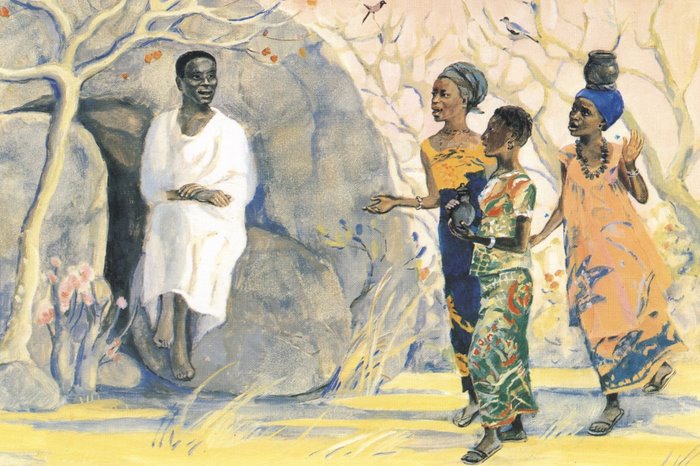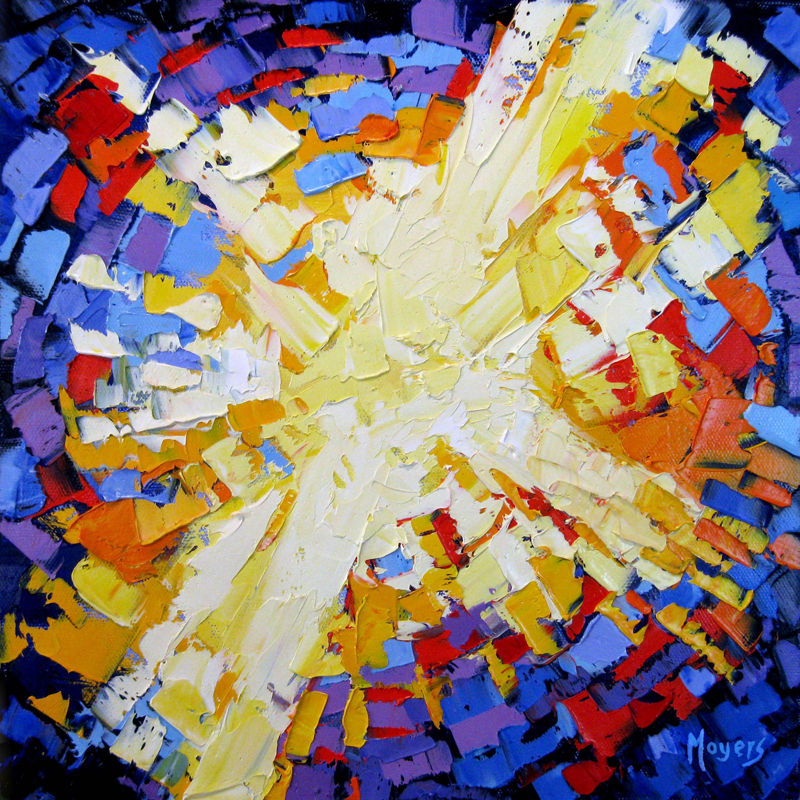Revised Common Lectionary Reflection, Resurrection of the Lord, Year B

April 4, 2021
Lessons: Acts 10:34-43 or Isaiah 25:6-9; Psalm 118:1-2, 14-24; 1 Corinthians 15:1-11 or Acts 10:34-43; John 20:1-18 or Mark 16:1-8
Theme: God’s faithful and generous people recognize the elements of terror and amazement that accompany Easter (or ought to) as we make sense of that which defies logic and holds space and time together in the risen Christ.
Key Scripture: So they went out and fled from the tomb, for terror and amazement had seized them; and they said nothing to any one, for they were afraid. – Mark 16:8
Do you like Easter? For many of us it evokes strong memories and good traditions, often hearkening more to the pagan roots of the holiday that Christian Easter was designed to replace (think bunnies, egg hunts, flowers, and more). For others Easter may be a more painful and discombobulating day, one that remains unsettled and unresolved. After all, how can these things be? The dead are supposed to stay dead. That’s why we have funerals and bury them. The world works according to certain principles; dead people just don’t, as a rule, get up and walk.
This is why I resonate with Mark’s gospel account and original ending, at verse 8 (a softer ending was added later). It seems honest and raw and true. Father Richard Rohr, a Franciscan friar, writer, and 21st century prophet, describes the life of faith as moving from order to disorder and then to reorder. It’s not an easy or particularly linear process, but he has a lot to say about how we who follow Jesus understand and live our faith. In a reflection posted on the website of his organization, the Center for Action and Contemplation, Rohr writes:
There are many models of human and spiritual development. We could describe three stages as Simple Consciousness, Complex Consciousness (both “fight and flight”), and Non-Dual Consciousness (“the unitive way” or “third way”). More recently, I have been calling the developmental stages Order > Disorder > Reorder. In short, I see this pattern in the Bible and in human lives:
- Order: We begin with almost entirely tribal thinking, mirroring the individual journey, which starts with an egocentric need for “order” and “self.” Only gradually do we move toward inclusive love.
- Disorder: We slowly recognize the invitation to a “face to face” love affair through the biblical dialogue of election, failure, sin, and grace, which matures the soul. This is where we need wisdom teachers to guide us through our “disorder.”
- Reorder: Among a symbolic few, there is a breakthrough to unitive consciousness (for example, figures like Abraham and Sarah, Moses, David, the Psalmists, many of the prophets, Job, Mary, Mary Magdalene, Jesus, and Paul). This is also what some call enlightenment or salvation.
Conservatives normally get trapped in the first stage, progressives are trapped in the second, and only a minority of either group seem to get to the third. The last stage is considered dangerous to people in the first stage, and rather unknown and invisible to people in the second stage. If you are not trained in a trust of both love and mystery, and also some ability to hold anxiety and paradox, all of which allow the divine entry into the soul, you will not proceed very far on the spiritual journey. (Click here to read the entire reflection.)

This is what happens when logic unravels, when disorder prevails, and when the world doesn’t behave in ways we’ve come to expect. Exactly here, in a place of disorder, Mary Magdalene, Mary the mother of James, and Salome find themselves. They have just watched their ordered lives fall apart with the horrible death of their beloved rabbi, the one they had believed with all their hearts to be the Messiah. They had hoped and assumed that he would restore the throne of David to power, overthrowing the oppression of Rome and the replacing the religious leadership with a new faith community. Can you imagine what they were thinking and feeling during the Passover observance? They must have been devastated. Yet doing what women are so good at doing, they pick themselves up, dust off their hopes and dreams, and prepare to do one last act of necessary and extravagant love for Jesus.
Completing the process of burial preparation is women’s work in first century Palestine. Gender roles and responsibilities are clearly delineated, although Jesus spent three years of ministry undoing and overturning many societal norms as he constantly drew a bigger and wider circle of inclusion. Now he is gone, and these three women come bearing burial spices and worry about how they will move the massive stone from the front of the tomb.
Things fall apart when they realize the tomb is already open. Therein they encounter a young man dressed in white who tells them to not be alarmed—yeah right. Then he confirms for them that he knows they are looking for Jesus of Nazareth, who was indeed crucified. The young man tells them Jesus has been raised and shows them evidence of his departure. This otherworldly envoy also instructs them to return and tell Peter and the disciples that Jesus in on the loose and headed to Galilee where they will see him.
What should be good news is instead mind-boggling. It challenges everything they know about the way the world works. Of course, as women they realized that reporting this news would get them laughed at or dismissed as crazy. They would not be taken seriously by the other disciples, men who were still clinging to order even as they slide into disorder.
Thankfully, as we know some 2,000 years later, this is not the end of the story. We do not have to remain in the comfortable womb of order, nor do we have to flail and fear in a state of disorder. By the grace of God and the amazing love of the Christ, we are freed to move ever onward into reorder. The women did. We know they eventually find the courage to share their news. Some of Jesus’ closest disciples get it, too. Friends, it is not easy to move from disorder into reorder. It’s much more comforting and easier to retreat to the first state of faith that Rohr describes—that of order. This sort of move is not Jesus’ desire for us, and it will not strengthen or grow our faith.

Easter, with all of its uncertainty, terror, and amazement, once again invites us to go into the world proclaiming the good news for all people. Easter invites us to go deeper and risk disorder so that we may emerge with Christ followers across the ages into a reorder that is all about healing the world and accepting our status as beloved children of God. Yes, Easter invites us to take a chance and listen to the Christ and the divine claim on all of creation. Christ is risen! Alleluia! Christ is risen indeed! May we embrace this beautiful truth as we move forward into a new era of being church together for the sake of the world. Amen.
In
Worship
Worship may still look a bit strange in your context.
Perhaps you’re still livestreaming worship or meeting outdoors. There won’t be
jubilant singing, but there will (hopefully) be masks and hand sanitizer. Who
will roll away the stone of pandemic for us? How will we respond to the very
real news that the Christ is alive and loose in the world, infusing every atom
and molecule of creation with renewal and hope? What will it take to see Easter
in new light? I have no clue what that will look like in your context, but know
dear preacher and worship leader that you will be lifted in prayer as you head
toward Sunday. We have a few miles yet to go, but we will get there.
There are so many beautiful and meaningful traditional Easter hymns, but if you’re looking for contemporary worship songs to capture the idea of order, disorder, and reorder, consider one of these two options:
With
Youth
We’ll be back next week with ideas for time with your youth.
With
Children
We’ll be back next week with
ideas for time with your congregation’s children.
Weekly
Stewardship Bulletin Insert
Alleluia, Christ is risen! Christ is risen indeed! Alleluia!
Today we give thanks for all who had a part in making our Holy Week and Easter
worship services possible. Thank you for your gifts of time, talent, and
resources that honor the risen Christ.
Stewardship at Home
Want to know more about Richard Rohr’s idea of order, disorder, and reorder? Why not pick up his book The Wisdom Pattern: Order, Disorder, Reorder? Click here for more information or check your local bookseller.
Have children or grandchildren at home? Consider making one of these two recipes with them on Easter Eve as a delicious way to illustrate that Jesus did not stay in the tomb but is risen and with us every day:
Empty Tomb Cookies
Empty Tomb Rolls
2018 Reflection: https://www.stewardshipoflife.org/2018/03/of-fear-and-foolishness/
2015 Reflection: https://www.stewardshipoflife.org/2015/04/good-news-that-never-ends/
2012 Reflection: https://www.stewardshipoflife.org/2012/04/a-story-for-uncertain-times/
Note: Reprint rights granted to congregations and other church organizations for local, nonprofit use. Just include this note: “Copyright (c) 2021, Rev. Sharron Blezard. Used by Permission.” Other uses, please inquire: thewritelife@hotmail.com.



Leave a Reply